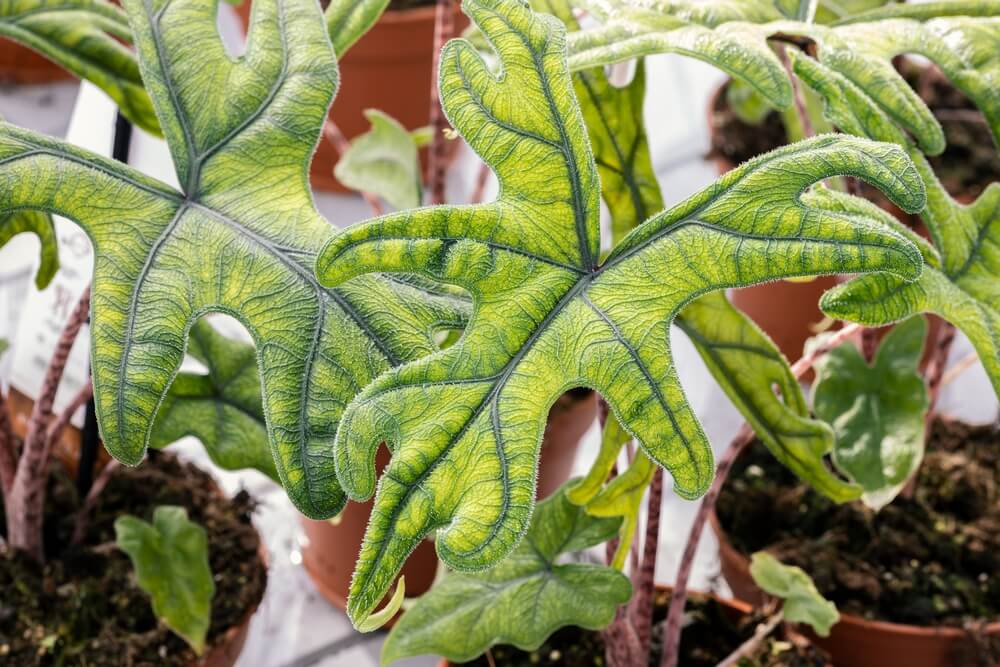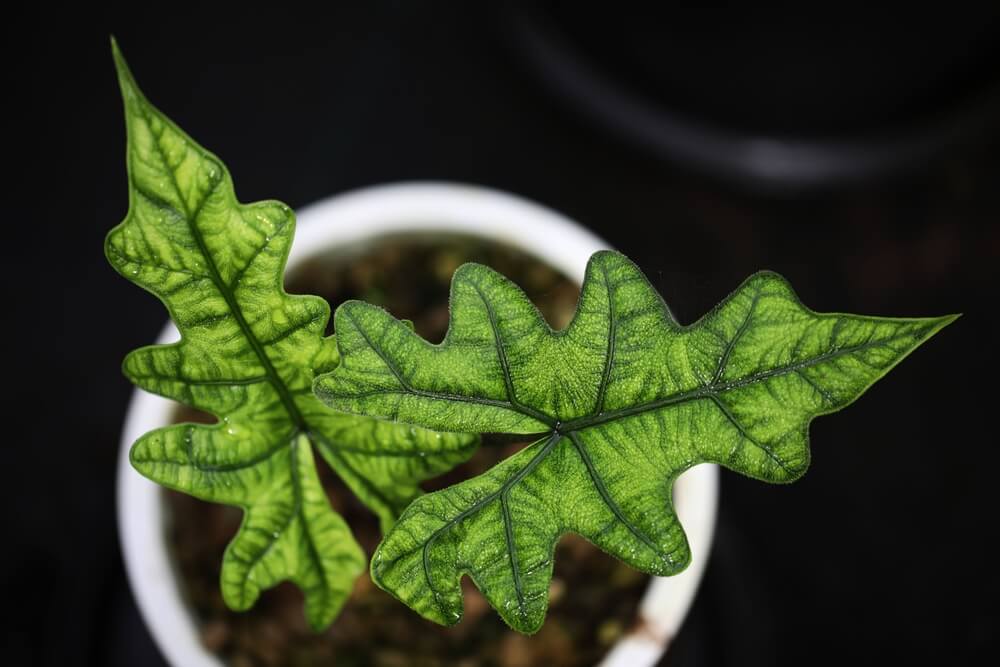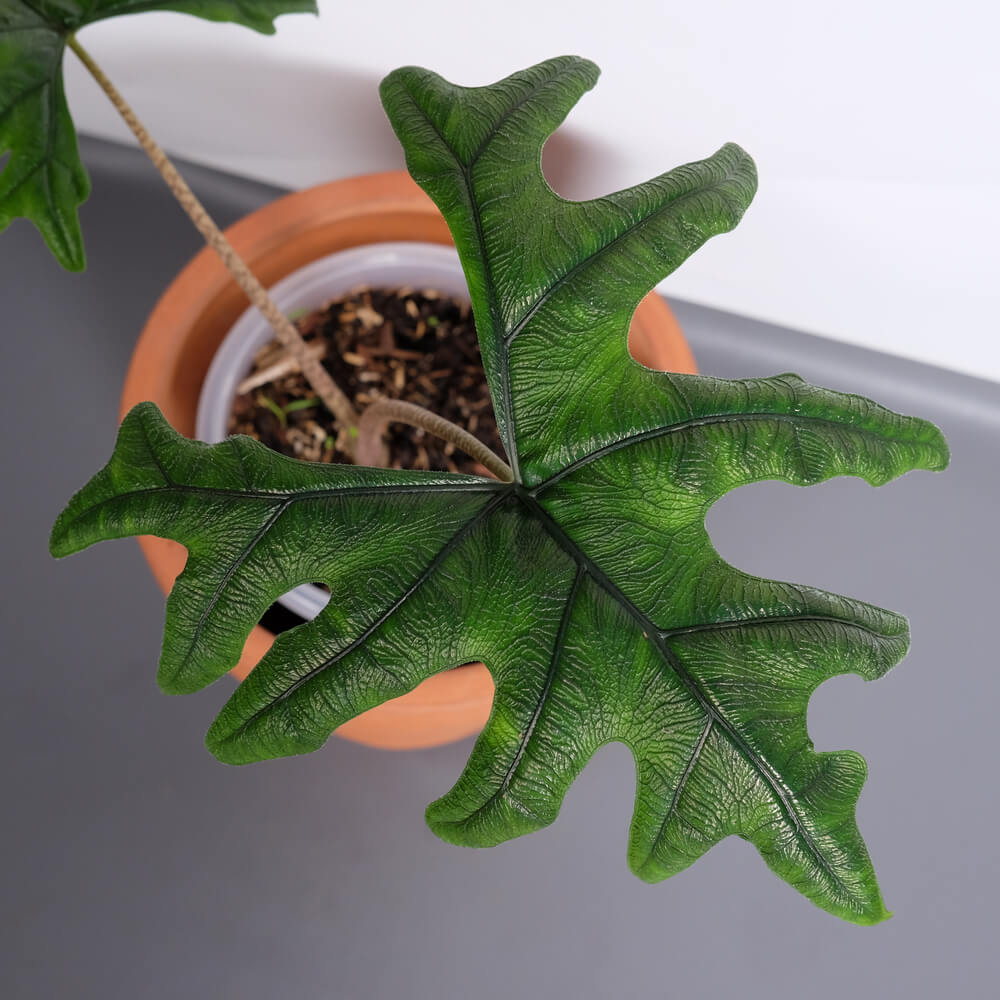The Alocasia Jacklyn is a stunning ornamental plant that originates from Indonesia. Because it’s still a new plant to the world, there isn’t much information about it to help plant lovers care for it properly. The article below will guide you on everything you need to know about this plant to ensure it flourishes.
In This Article
What is an Alocasia Jacklyn (aka Alocasia Tandurusa)?
The Alocasia Jacklyn is a type of aroid with striking green foliage and purple or dark green veins going through the leaves. The plant is believed to have mutated from the Alocasia Portei, although research is yet to confirm this.
Alocasia Jacklyn has quickly become a favorite among plant lovers because of its mesmerizing visual appearance that will give your home a jungle-like look. If that isn’t enough reason to get it, we don’t know what is.
As with most plants, to enjoy the beauty of Alocasia Jacklyn, you have to know how to care for it. Fortunately, it’s easy to grow, and caring for it isn’t complicated.
Features of the Alocasia Jacklyn
Here are some features of this plant:
https://www.shutterstock.com/image-photo/close-alocasia-jacklyn-leaves-unique-texture-1956042400
- Leaves: Moderate to large, depending on the size of the plant. Most are between 20 to 90 cm with arrow-like shapes.
- Height: In the right conditions, they can reach as high as 10ft when grown outside. When used as houseplants, they can reach about 80 cm high.
- Stems: The stems are stiff with a purplish color, but most of the time, they aren’t visible because the large leaves cover them.
- Toxicity: Alocasia Jacklyn is neither toxic to animals nor humans on touch. But avoid ingesting it as it can be harmful, causing irritation and swelling in the mouth.
How to Care for Alocasia Jacklyn
This plant requires moderate care and trimming twice a year. Depending on your preference, you can grow it as an indoor or outdoor plant. Either way, here is the basic care for it.
Light Requirements
Since it’s a tropical plant, it prefers sunlight to shade. The leaves are tender, meaning direct sunlight will burn them, turning them brown.
Your indoor plants will still thrive even without too much sunlight. Just remember that light gives the leaves that vibrant color that makes the plant stand out.
Temperature
As we’ve mentioned, Alocasia Jacklyn originated from Indonesia, a country that receives warm temperatures the whole year. As such, the plant will be happy between 17°C to 22°C.
They are also sensitive to extreme cold weather. Don’t leave the plants outside if temperatures are below 15°C. Keeping the temperature steady in the house when the temperatures drop outside will help the plant grow well.
Watering Requirements
Alocasia Jacklyn prefers constant moist soil. That means you can water it twice a week and once a week in winter.
Avoid adding too much water because soggy soil damages the roots. At the same time, don’t let the soil dry out completely, because this plant isn’t drought-tolerant.
Fundamentally, don’t rely on a watering schedule too much. Instead, check the soil constantly to see if the plant needs watering or not. If the top 1 to 2 inches of soil is dry, go ahead and water.
Humidity
Your Alocasia will do well in a humid environment. Plant experts suggest humidity levels of 60% or higher. You can increase the humidity levels around the plant using a drip tray or humidifier.
Soil Requirements
This plant prefers airy and well-draining soil. Plant it in loose soil and ensure the pot has many drainage holes.
Avoid a heavy mixture of dirt because it easily damages rhizomatous plants. Also, don’t use rocky or sandy soil because it can block drainage, preventing adequate oxygen supply to the roots and causing them to rot.
Drought and Disease Resistance
As mentioned, this plant doesn’t do well in drought-like conditions. It needs adequate water to grow well. Otherwise, the foliage will soften, wilt and die.
It’s also not disease-resistant. Root rot and leaf infections are common if one doesn’t care for the plant properly.
Root rot occurs because of excessive watering and insufficient oxygen. Allow the soil to dry before watering.
Fertilizer Requirements
Although Alocasia Jacklyn needs fertilizer, it’s not a heavy feeder. Applying urea-free fertilizer every month allows healthy growth during its growing stage, which is summer and spring.
Avoid applying fertilizer during winter and fall, as the plant goes into a dormant phase during those seasons. Also, dilute the fertilizer twice as much as recommended by the manufacturers.
Concentrated fertilizer will facilitate faster growth, which can be an issue when this is an indoor plant, and you don’t have enough space.
The right fertilizer for the Alocasia Jacklyn plant is a balanced mixture of NPK 20-20-20 fertilizer. That’s good enough for your plants to grow strongly.
Avoid chemical fertilizer as it can damage the plant, and don’t apply too much fertilizer. The salt can build up in the soil, damaging the roots and causing the leaves to turn yellow.
Pruning
An Alocasia Jacklyn can reach as high as 10ft when grown outside, and the leaves can also grow up to one foot long. Indoor plants won’t grow to be that big, but they can still get to 3 to 4ft.
Because these plants grow fast, in six months, you may be looking at a large plant with leaves growing in all directions. Pruning the leaves gives the plants space to grow.
Pruning the plant every six months will promote a bushier plant by encouraging more leaves to grow. When doing this, remember to remove infected, old, damaged, and dying foliage.
Propagation
There are two ways you can propagate the Alocasia plant. They include:
- Separate the offsets
- Divide the rhizomes
Offsets grow at the base of the plant, emerging from the roots. Unfortunately, they grow in their own time, and you can’t predict when you’ll have the opportunity to propagate using them.
Still, it’s simpler than the rhizome method. You only need to cut them from the parent and plant them in their own pots. They will grow to be the exact copies of the parent plant.
To propagate during the division method, you have to remove the plant from the pot to see the roots properly. The root system has many interconnected rhizomes, each with its own root system.
Divide the rhizomes using a sterile knife and plant the cut sections in the soil. In a couple of months, you’ll have multiple plants.
Repotting
Because this is a fast-growing plant, you need to re-pot it every 12 to 18 months. This schedule is merely a suggestion, and you don’t necessarily need to follow it.
If you notice the roots bulging even before 12 months end, repot the plant. Understand that the plant doesn’t like being moved because that can strain it. Re-pot only when necessary.
The new container should be 2 inches bigger than the current pot. Too big a pot increases the risk of overwatering the plant.
Should I Mist the Plant?
Misting the plant frequently will boost humidity levels, especially if you live in a dry area.
What Can I Do If the Plant Has Yellow Leaves
Leaves will turn yellow if you’re underwatering or overwatering. If the yellow leaves are accompanied by leaf drops, your plant needs more water.
What Are Some Common Problems With This Plant?
Some of the challenges you can experience with this plant are as follows.
- Leaves turn yellow: This is caused by overwatering and underwatering.
- Leaves turn brown: Caused by lack of enough sunlight, underwatering, or the plant being too cold.
- Diseases: Overwatering can cause root rot or bacterial and fungal infections.
- Pests: The plant can be susceptible to common houseplant pests like scale, mealybugs, and spider mites. If you notice an infestation, isolate the plant and spray it with insecticidal soap or neem oil.
Is the Alocasia Jacklyn Rare?
The Alocasia Jacklyn is a newly discovered plant, therefore very rare and highly sought after.
How to Make Alocasia Jacklyn Bigger
This can be quite difficult, considering that many environmental factors will influence how big the plant grows. The best way to get a bigger plant is to let it absorb enough light. Doing this will keep the plant healthy and allow the leaves and plants to grow to their maximum potential.
Why Is My Alocasia Jacklyn Not Growing?
Many things can lead to poor or stunted growth. The first thing you should check is if your plant is getting enough light, as poor lighting is usually the main culprit.
Your plant should get about 8 hours of indirect light every day. But if that is good, check if your soil is draining properly and that the humidity levels are not less than 60%.
Alocasia Jacklyn Vs. Alocasia Zebrina
The Alocasia Zebrina is the closest plant to the Alocasia Jacklyn. The major difference is that the leaves for Jackyyn are segregated, while those for Zebrina are full.
Both are tropical plants, but Zebrina originated in the Philippines. All the other requirements are almost similar.
Alocasia Jacklyn Price
The Alocasia Jacklyn can range anywhere from $30 – $150 depending on maturity and where you’re purchasing the plant from.
Where Can One Find the Alocasia Jacklyn for Sale?
Despite the plant being rare, you can find it in a lot of plant shops. Check in with your local plant shop or online shops like Etsy, Amazon, and eBay.
Frequently Asked Questions
Additional Sources & Resources
-Alocasia ‘Jacklyn’: https://www.missouribotanicalgarden.org/PlantFinder/PlantFinderDetails.aspx?taxonid=282935&isprofile=0& cultures=1&opt=4
-Alocasia ‘Jacklyn’: https://www.gardenia.net/plant/alocasia-jacklyn-alocasia
-Alocasia species: https://en.wikipedia.org/wiki/Alocasia
-How to grow and care for Alocasias: https://thejoyofplants.com/en/how-to-grow-and-care-for-alocasias/
-Popular Alocasias: https://www.bhg.com/gardening/houseplants/care/popular-alocasias/
-Alocasia Cornelliana care: https://www.houseplantsexpert.com/alocasia-cornu-elephant-ears.html
-Alocasia ‘Hilo Beauty’ Plant Profile: https://www.thespruce.com/hilo-beauty-alocasia-3217768
-Alocasia ‘Pink China’ Plant Profile: https://www.thespruce.com/pink-china-alocasia-3217769
-Alocasia ‘Red Secret’ Plant Profile: https://www.thespruce.com/red-secret-alocasia-3217770
-Alocasia ‘Sarian’ Plant Profile: https://www.thespruce.com/sarian-alocasia-3217771
-Alocasia ‘Silver Dragon’: https://www.houseplantexpert.co.uk/houseplants/a4i2/alocasia_silver dragon.html



